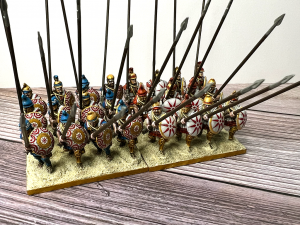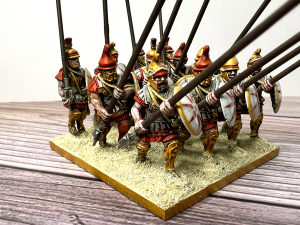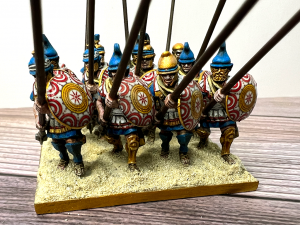Siege Army Update (part 1)
Are you participating in the Siege Army raffle? With just a little over a month until SOA XXXIII, now’s the time to get serious about putting together painted, based unit to contribute. You still have time to source figures and paint them, or find a unit for sale or trade (that’s right; there’s no requirement that you actually paint the unit, yourself).
What to bring?
The theme of the Siege Army is “Desert Wars of the Ancient World”. That’s pretty handwave-y on purpose. In general, these are the units to bring that you get a Siege Army raffle ticket:
- 25/28mm unit (Ancients)
- Fully painted, based for desert
That’s it.
Now, if you haven’t yet decided what to bring, this may not be help you narrow down your choices. Or, you don’t even know what the choices are. I’ve compiled a non-exhaustive list of possible sources of inspriation.
The Biblical Era
As part of the Fertile Crescent, the Levant was lush and filled with arable land, making it a prize worth fighting over. However it also contained vast swaths of arid and semi-arid land, stretching from the Negev (literally, “desert”) in modern-day Israel all down through Egypt and into North Africa. Civilization in these areas concentrated around natural springs and waterways. As such, competition for resources was heightened and the potential for conflict increased.
The oldest recorded battle in history is the Battle of Megiddo (c. 1457 BC), part of Pharoah Thutmose III’s conquest of the Canaan. This began a period of Egyptian expansion that spilled out into modern-day Libya, Syria, and southern Egypt (Nubia). The battle of Kadesh (c. 1274 BC) between Ramses II’s Egyptians against the Hittites was the largest chariot battle in history. The Battle of Djahy (c. 1178 BC) cemented Ramses III’s conquest of the Philistines, who themselves waged war throughout the Levant.
Many wars in this era concentrated in what is modern Syria and Jordan; these areas are far more arid than the Levantine coast or the Fertile Crescent. As towns and cities sprang up around watering holes and oases in this region, the great powers of the time began contesting for them. Belligerants of this time included the Philistines, Phoencians, Hittites, Egyptians, and whatever flavor-of-the-century the Amorites, Akkadians, and Kassites founded between them (e.g. the Babylonian and Assyrian Empires, and various iterations thereof).
Just south and west of the Levant, Egypt (in various forms) continued fighting against Nubians, Libyans, and Sherden (Sardinians).
All these various powers were eventually subjugated and subsumed by the Achaemenid Persian Empire under Cyrus II and his sons.
Suggested units
- Chariots
- Cavalry
- Infantry with spear or swords
- Bowmen (also, mounted bow)
- Skirmishers with javelin or sling
The Hellenistic Period
Greeks had been invading the North Africa and the Levant for centuries, in form of various Sea Peoples. The Macedoneon conquest and co-optation of Athens and Corinth by Philip II paved the way for a new, more organized Graeco-Macedonian incursion under Alexander the Great; this time against a region wholly unified under the Achaemenid Persion Empire. Alexander went on to capture Anatolia, Tyre, Gaza, and Egypt (bloodlessly, at that). There is a lot more to be said about this these events, but for the purposes of discussing desert battles, we look at the capstone of Alexander’s invasion: the conquest of Babylon and the Battle of Gaugamela.
After the successful capture of Tyre cemented his control of Asia Minor, Egypt, and Syria, Alexander turned toward Babylon. Without supplies or water, the Macedonians force-marched through the Syrian desert (in 120-degree daytime heat and below-freezing nightime temperatures, no less), all the while being harassed by the Persians. Still, they avoided pitched battle until Alexander reached Gaugamela, in norther Iraq, where Darius was waiting. The actual battle, itself, was on the banks of the Bumodus River, halfway between Gaugamela and the ruins of Nineveh on the Tigris River. Even still, this area was hot, arid, and sandy. Darius had chosen this ground because it was wide and flat, and accorded the most manouverability to his scythed chariots (which would, in any event, prove ineffective against the Macedonian phalanx). The battle became confused as billowing dust from the movement of battle obscured all action. Darius was, at one point, mistakenly thought killed, and half the army fled. On the other end of the field, Persians and Macedonians milled around blindly. At one point, Persian cavalry somehow passed, unseen, all the way through Alexander’s front line and found themselves at the Macedonian baggage train. This action required Alexander to put off pursuit of the routed Darius to save his other command.
From there, Alexander went on the capture Persepolis, and invaded India up to the Hyphasis River, where his army mutineed and demanded to return home. Unfortunately, the way home lay through the Gedrosian Desert for a 60-day march; only a fraction of his army survived the trek.
Shortly thereafter, Alexander died. When asked to whom the kingdom should be bequeathed, he said, “To the strongest.” Thus began 40 years of war between the “Successor” states. The most powerful of these Successors were the Antagonid (Macedonia), Ptolemaic (Egypt), and Seleucid (Syria) kingdoms. These dynasties retained a distinctly Graeco-Macedonian identity until the dissolution of the system of land grants for military service (after which, the respective armies relied exclusively on native soldiers and foreign mercenaries, and the Macedonian phalanx disappeared into history).
The most significant conflict of this period were the Syrian Wars, six wars over a hundred years between Ptolemaic Egypt and Seleucid Syria (seven, if you include the over-complicated Seleucid Dynastic Wars, with its constant betrayals, double-crosses, and manipulations). The end result of these conflicts is dizzying. Ptolemy VI deposed the Seleucid king Demetrius, installed a puppet (Alexander Balas), betrayed the puppet and married his own daughter off the the son of the king he’d just deposed (Demetrius II), and then he and Alexander pretty much killed each other in battle. Demetrius II ascended to the throne.
In short: The Ptolemies conquered the Seleucids, and then the Seleucids inherited both kingdoms. Whatever.
After a while, the Parthians (modern Iran) conquered the remnants of the Seleucid Empire, and all parties involved were eventually annexed by an ascendant Rome.
For desert war, this is the most interesting period. All sides had heterogenous composition, with mercenaries, chariots, and elephants. The phalanx remained the core of each army up until the final iterations of the war. One example is the Battle of Raphia, in modern Gaza, which decided the Fourth Syrian War.
Suggested units
Mostly, the same as above, but with the following additional troop types:
- Heavy infantry with sarissa (pike) or spear (phalangite, hypastist)
- Infantry with spear (hoplite)
- Skirmishers with javelins (peltast)
- Scythed chariots (Persian)
- Elephants (Asian, African, and/or Indian, depending on the army)
- Cataphracts (later Syrian Wars)
The Roman Era
The Roman and Parthian Empires first came into contact during their collective dismantling of Seleucid Syria. There are initial attempts at alliance between the two; but as each began acquring client states in the Mediterranian, it was became increasingly difficult to remain neutral. The peace was broken when the Parthians supported Pompey over Caeser in the Roman Civil War. From then on, the Parthian Empire was Rome’s enemy.
One of the most significant battles between them was also its opening engagement: the Battle of Carrhae (53 BC). The First Triumvirate was in crisis: Pompey and Caeser had formed and alliance, and Crassus threatened to be sidelined without significant military victory. Thus, he embarked on an independent, ill-advised invasion of the Parthian Empire. The Battle of Carrhae led to the death of Crassus and the loss of 30,000 legionnaires; this was the majority of his expeditionairy force. The Romans were vastly outnumbered, and combined arms with cataphracts and horse archers with limitless arrows (Parthian general Surena had thousands of camels constantly resupplying them throughout the battle) completely neutralized the testudo formation.
The loss was a humiliation for Rome, and a triumph for the Parthians. However, the Parthian king was jealous of Surena’s glory, and had him executed. Thus, the Parthians lost their finest general, and the Romans learned a valuable lesson in combined arms that made their subsequent forces all the more formidable. Rome’s war for Persia didn’t end with Parthia’s overthrow in 216 AD by the Sasanian Empire; rather, this new belligerent took Parthia’s place. The Sasanians waged 400 years of uninterrupted war against Rome, and its regional successor Byzantium.
Note: The lack of mention of the Punic Wars was no oversight; while the current site of Carthage is a desert, it was not so during its heyday. The Carthaginians (to the best of my knowledge) did not fight in the desert. Conversely, there are a number of battle sites that are currently verdant fields and farms; but only because of over two millenia of irrigation. However, the sites that have changed the least (ecologically speaking) can be found in the interior of Syria.
Suggested units
Most of the traditional Graeco-Macedonian-specific units were gone by this time; the Seleucid and Ptolemaic armies were now wholly composed of native troops. But the introduction of Roman Republic and and Imperial ambitions to the area add their respective units to the list of possibilities. At the Battle of Carrhae, the Romans also relied heavily on Gallic troops.
Other Suggestions
The various battles for Syria and its surroundings are low-hanging fruit for sourcing desert armies, but they are by no means the only examples. India and Africa are also great sources for armies (although an accurate representation of the already listed armies will include mercenaries and levies from these areas).
Finally, all of the armies listed above employed troop types that never quite went out of fashion, and were usually indistguishable between armies; this is especially true for unarmored and skirmish troop types. Slingers, bowmen, and light cavalry/camelry are (more often then not) fungible between all the different armies across the periods listed above, as are elephants.
Basically, there exist few armies for which there is no possibility that they fought in the desert. Be imaginative and bring whatever suits your fancy!
Next update: So you grabbed some troops at the last Siege. How do you paint them? The short answer is: “however you want.” The long answer is also “however you want”, but with some research notes.



